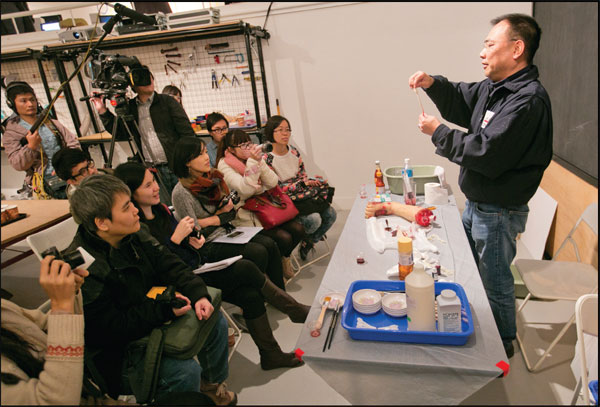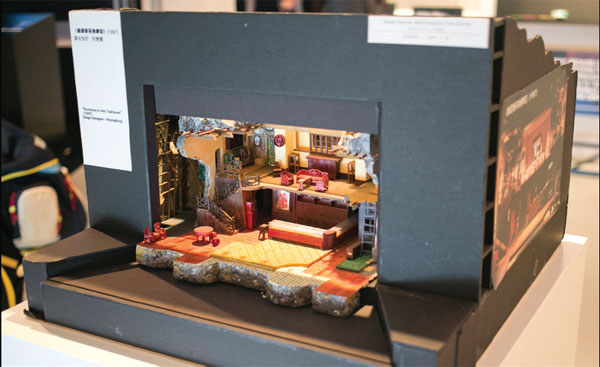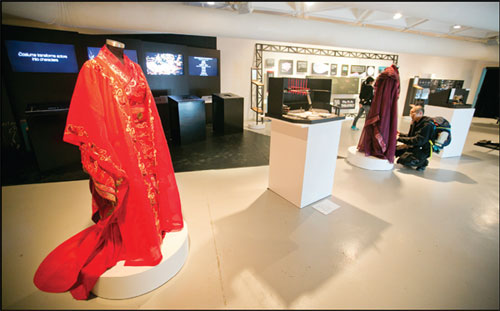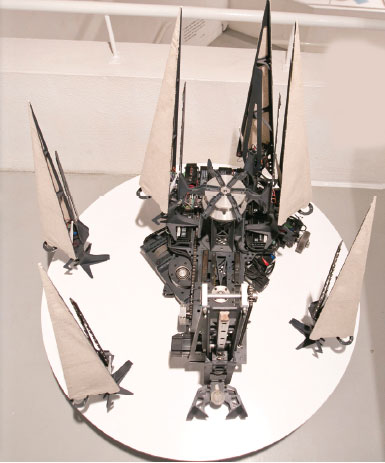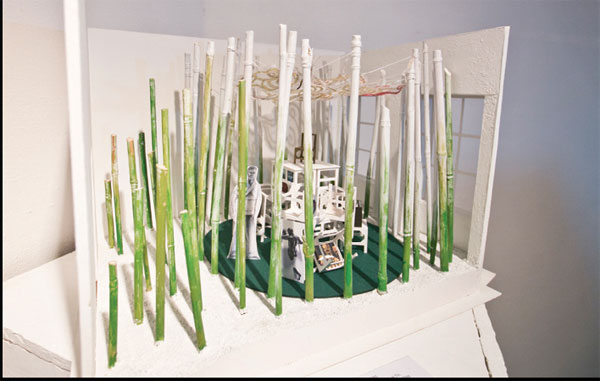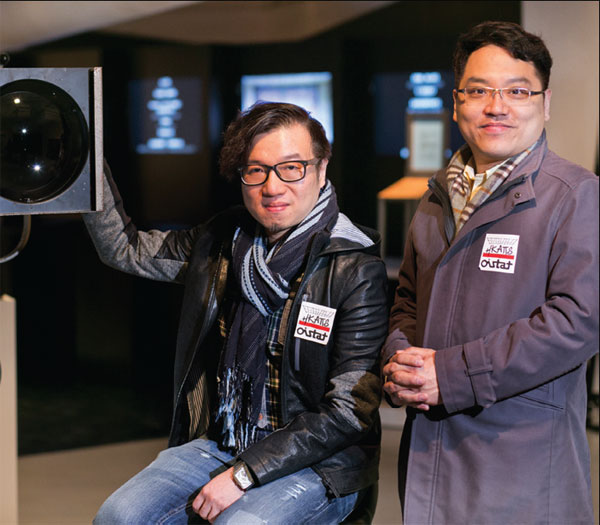Backstage at the forefront
Updated: 2015-01-27 10:19
By Chitralekha Basu(HK Edition)
|
|||||||||
Those who toil behind the theatrical props and the tools they use to create magic on stage, are getting their chance to take a bow, during an exhibition at the HK Arts Centre this week. Chitralekha Basu was there.
It's a show about things theater-goers normally won't see. That includes the people who create magic on stage, but never appear before the audience, and the tools they use. The spotlight, for a change, is turned on the backstage in Parallel Space - an exhibition put together by The Hong Kong Association of Theatre, Technicians and Scenographers (HKATTS) at Pao Galleries, Hong Kong Arts Centre (on until Feb 1).
"In Hong Kong we have 400 plays a year (not counting opera, musicals, stand-up comedy and other forms of performance)," says Law Kwok-ho, chairperson of HKATTS, whose first conceived the idea for the exhibition. "So if there are 25 personnel involved backstage in each of these that makes 10,000 people. This is our chance to show the amazing power and talent these people have invested in theater down the ages."
The idea of preserving the tools and technology that go into a stage play - a transient experience by its very nature - is a laudable effort and an ambitious one, considering the sheer numbers involved. And in Hong Kong a play in performance is even more ephemeral compared to certain other cultures. Playing seasons last just one to two weeks, and the sets are dismantled soon after. Therefore the move towards exhaustive documentation and showcasing of the props, costumes, photographs, texts, light and sound equipment employed in theater is particularly significant and meaningful.
Parallel Spaces offers both an overview of the theater scene and a still-evolving database of theatrical productions staged in Hong Kong since 1962. Information on over 1,000 plays staged since 2011 - comprising amazing high-definition hologram installations of selected scenes from notable productions, such as Heart of Coral (2013), based on the life of the writer Xiao Hong - is already in the multimedia archive and will soon be available to download on Android devices.
The word "parallel" in the show title could be interpreted in a number of ways. The exhibition is mounted across two floors, much like a two-tier stage. The upper deck is mainly for display. Examples include old-style profile spotlight (brand Pattern 23), lovingly nicknamed "pig's snout" in Hong Kong, prompt books from the 1960s, rigging systems for hanging sets, a robot used to maneuver the lights in Gaybird Leung's funky audio-visual show, CouCou on Mars.
Just like cooking
The floor beneath is more of an activity center, where technicians demonstrate the intricacies of their craft. We caught project coordinator Lau Hon-wah teaching a rapt audience the art of creating blood on stage. "If you're vomiting blood on stage, better use edible material," he said. "But ketchup won't pass for blood, will it?"
Honey, he said, made the ideal base for blood, pouring some into a glass with a knowing smile. "The color does not look like blood but the texture does. So we add some edible artificial color. Three drops of red and one of black. There, that's more like it. Keep adding a bit of this and that until you get the right color and consistency. It's just like cooking," said Lau, taking obvious delight in the range of emotions he inspired in his audience as he pumped the liquid into a condom and taped it on a plasticine model of a severed foot before slitting the thing open to let the liquid ooze out.
The whole picture "Parallel Spaces", says Allan Tsui, co-curator of the show, "is about the theater scene in Hong Kong, then and now." The history of professional theater in Hong Kong isn't that old, he says, only about 37 years, if one takes the founding of Hong Kong Repertory Theatre in 1977 to be the beginning. "It's possible to get a better perspective when we put two images - the past and the present - side by side. It makes us think and find more things in between. Looking at the same play performed 10 years later makes us ponder the differences and how these were informed by ourselves and society at different points in time."
Doubtless, the exhibition will open a floodgate of memories for many of the technicians who visit it. Virginia Kam graduated with a degree in theater lighting design from the Hong Kong Academy of Performing Arts in early 1990s. She went on to win the award for Best Lighting Design in 2000, and had mixed feelings when she came across a floor plan from a much earlier play - The Rise and Fall of the City of Mahogany by Bertolt Brecht. It was the play in which she cut her teeth into the business. "I had a hard time with this one," she said, visibly relieved now that she can look back on that phase of her life with greater objectivity. "The costume designer and set designer had their own ideas about the play and I was often left with the task of mediating between them."
Interestingly, some of the model sets are not based on actual plays - written or performed. They are purely imaginary in nature - developed from a spark inside the set designer's head - ideas turned into three-dimensional models on a scale of 1:50, compared to the size of a regular proscenium stage.
There are miniature models of a capsized boat and a cottage on a green patch surrounded by poles (which could be a metaphor for the threat of urbanization looming over the pristine setting). The idea is to recognize the theatricality inherent in everyday life, situations and objects, even if they do not necessarily lead to a play.
These are the chosen ones among entries submitted for entry in the Prague Quadrennial of performance Design and Space - the world's largest exposition of contemporary experiments in stage, costume, light and sound design. HKATTS commissioned and screened entries submitted by Hong Kong theater designers for the contest in Prague.
Prague beacons
This year they chose a rather hip model of a replica of a regular proscenium stage, the space inside which was being used to screen holographic installations. Heat-sensitive paint was used to inscribe the words, "Why Theatre Exists", on the elevation to the stage. The letters vanished one by one, though not in the order they were written, when the temperature went down, forming all sorts of unlikely combinations.
Tsui regretted that while the HKSAR government has sponsored the building of film archives, it was perhaps not so concerned about preserving the city's theater heritage.
"We don't have a very good method of keeping records. So we wanted to start a movement in that direction and this is just the first step. We would like the government and public to pay more attention to building a theater archive."
Contact the writer at basu@chinadailyhk.com
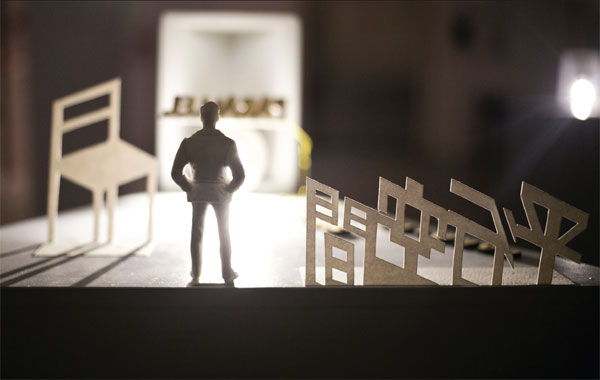
|
Lau Hon-wah, a project coordinator, teaches the nitti-gritty of making blood on stage to an enraptured audience. Edmond Tang / China Daily |
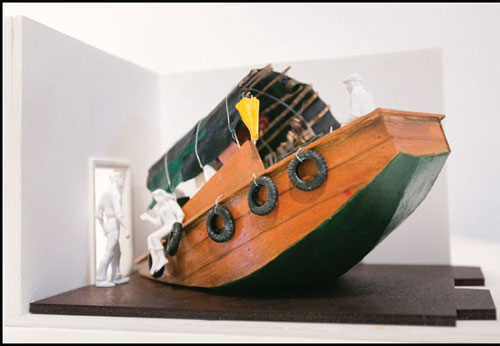
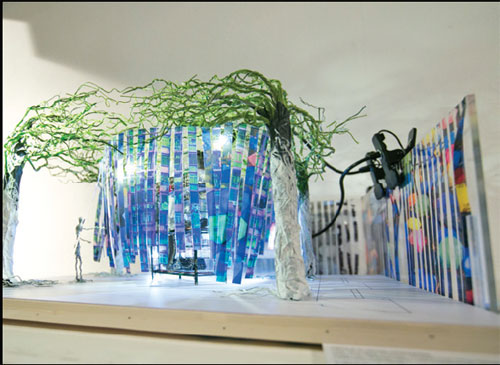
|
A miniature replica of the elaborately-detailed two-tier set of the play Romance in the Teahouse (1997). |
|
From Qing Dynasty era costumes to an enormous database on theater ready for digital display, the Parallel Space exhibition has it all. |
|
A robot used to maneuver the lights in Gaybird Leung's funky audio-visual show, CouCou on Mars. |
|
Model of design installations to be mounted at Prague Quadriennale this summer. |
|
"Parallel Spaces," says Allan Tsui (left), co-curator of the show, seen here with HKATTS chairman Law Kwok-ho, "is about the theater scene in Hong Kong, then and now." |
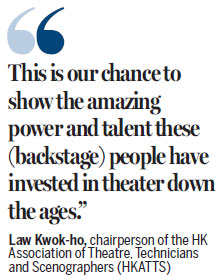
(HK Edition 01/27/2015 page7)
